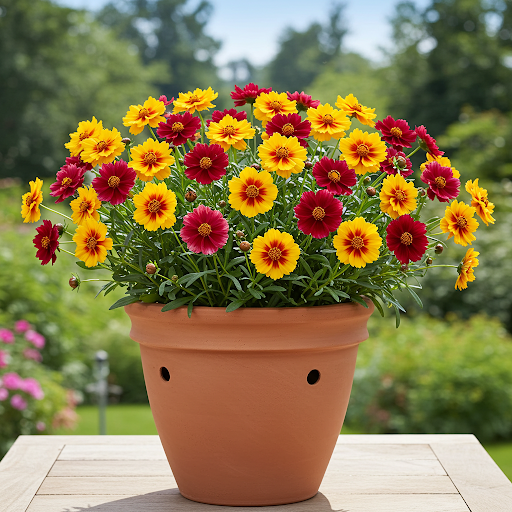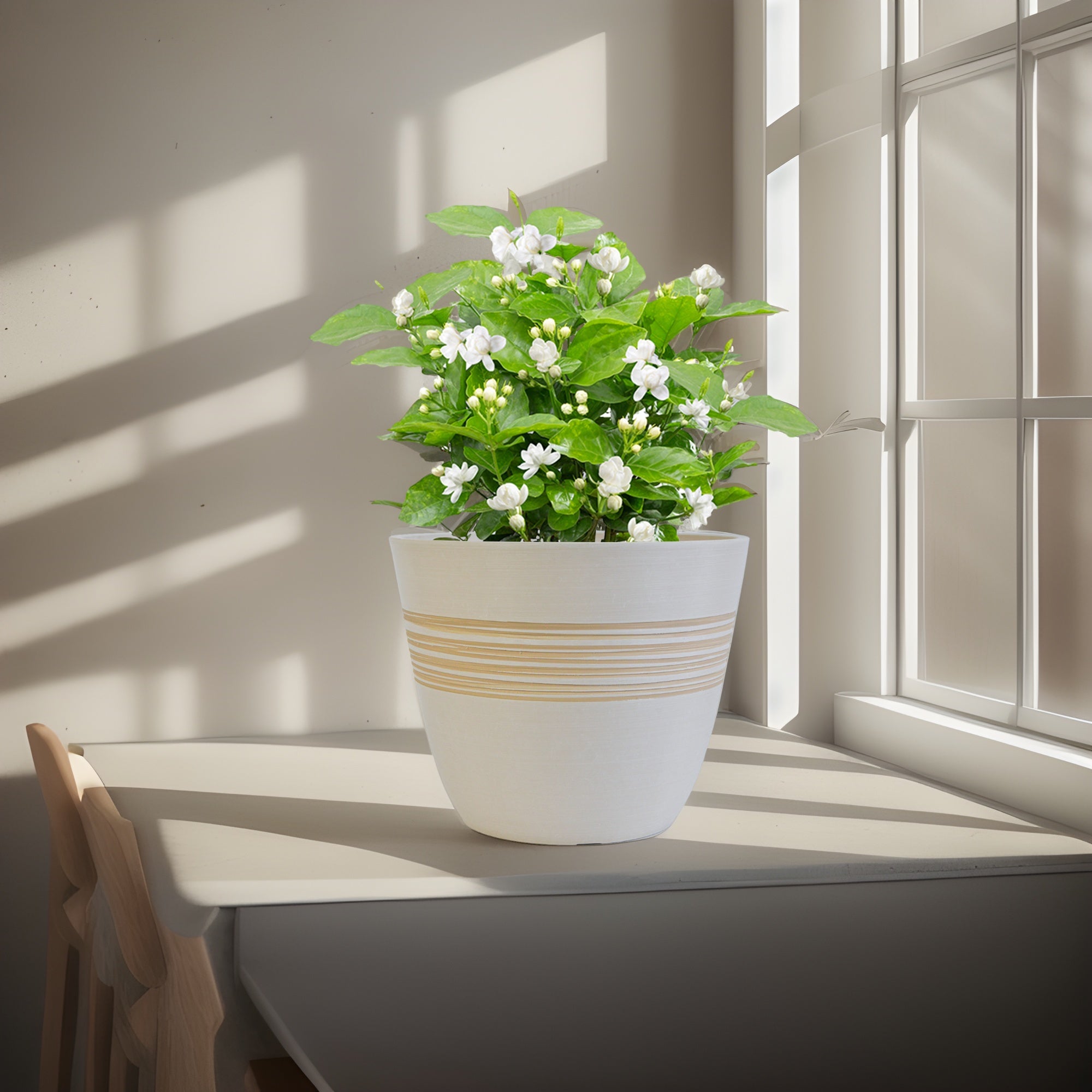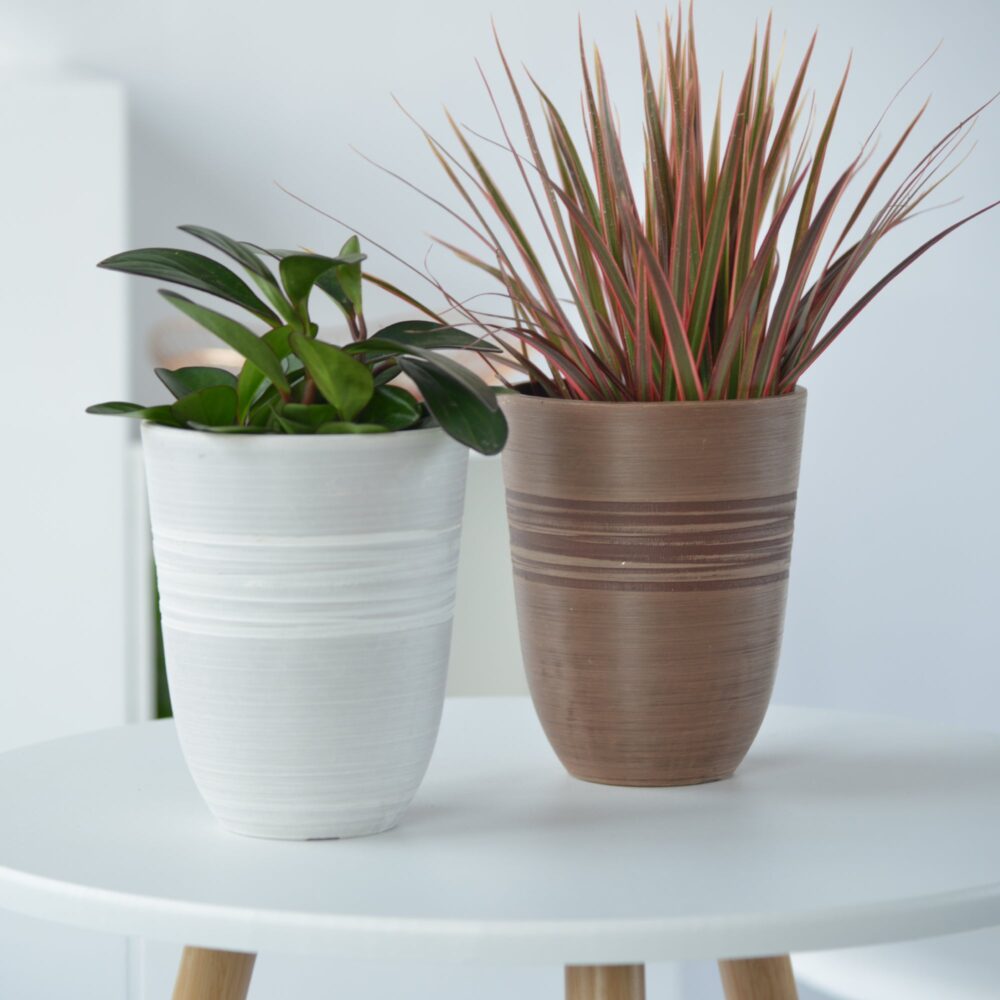Coreopsis in Pots: The Complete Guide to Growing Sunny Coreopsis Outdoors in Containers
Want to brighten your patio, balcony, or garden with masses of cheerful, daisy-like yellow or golden blooms? Coreopsis, often called Tickseed, is a wonderfully easy and rewarding choice for outdoor container gardening. Celebrated for their sunny, daisy-like flowers in shades of yellow, orange, and red, and their long blooming season and low-maintenance nature, Coreopsis are perfect for adding carefree color to sunny outdoor spaces. This comprehensive guide will provide you with everything you need to know to grow Coreopsis successfully in outdoor pots, from selecting the best varieties and containers to mastering essential care techniques for a season filled with Coreopsis sunshine.

Coreopsis
What are Coreopsis (Tickseed)?
Coreopsis, commonly known as Coreopsis or Tickseed, is a genus of flowering plants belonging to the Asteraceae family (daisy family). Native to North and South America and Africa, Coreopsis are popular annuals and perennialsgrown for their abundant, daisy-like flowers and long blooming season. Coreopsis flowers are typically golden yellow or bright yellow, but also come in shades of orange, red, pink, and bi-colors, often with contrasting centers or patterns. They have a classic daisy flower shape, with ray florets (petals) surrounding a prominent central disk, and often exhibit notched or toothed petal tips, giving them the “tickseed” appearance. Coreopsis plants exhibit diverse growth habits, from compact and bushy to upright and airy, ranging in height from under a foot to several feet tall, depending on the species and variety. They are known for their sunny disposition, long blooming season (summer to fall), cheerful colors, low-maintenance nature, and attractiveness to butterflies and beneficial insects, making them an invaluable addition to gardens and containers, especially for adding continuous summer color and attracting wildlife.
Are Coreopsis (Tickseed) Good for Outdoor Pots?
Yes, Coreopsis (Tickseed) are exceptionally well-suited for outdoor pots and container gardening. Their long blooming season, adaptable growth habits, tolerance of various conditions, and sunny flower colors make them ideal for filling pots, window boxes, hanging baskets, and mixed container arrangements with cheerful, daisy-like blooms. Coreopsis thrive in sunny locations and bloom profusely throughout the warm season, providing a long-lasting and delightful floral display in containers. Their low-maintenance nature and bright, sunny flowers make them a fantastic and rewarding choice for container gardens of all styles, especially for adding a touch of cottage, wildflower, or sunny garden charm to patios, balconies, and decks.
Ideal Growing Conditions for Coreopsis in Pots:
Types of Coreopsis for Pots: Many Coreopsis varieties are excellent for pots, but consider your desired height, flower color, and habit when choosing:
- Dwarf Coreopsis: (Coreopsis grandiflora dwarf types, Coreopsis verticillata dwarf varieties) – Compact and smaller in stature, typically under 12 inches tall. Ideal for small to medium pots, window boxes, and edging. Known for their neat, bushy habit and profusion of smaller flowers. Excellent for creating dense, colorful displays in pots and for the front of mixed arrangements. Look for varieties like ‘ মৌরিসিয়েন Series’, ‘ ক্রিস্টীয়ান Series’, ‘Nana’, and ‘গোল্ডেন Showers’.
- Compact Coreopsis: (Coreopsis grandiflora compact types, Coreopsis lanceolata compact varieties) – Reaching 1-2 feet tall, these are versatile and popular for general garden use and containers. Suitable for medium to large pots and mixed containers, providing a good balance of height and flower size. Offer a wide range of yellow and golden hues, and single or semi-double flower forms. Look for varieties like ‘Early Sunrise’, ‘Sunfire’, ‘ জাগের Series’, and ‘Limerock Ruby’ (red).
- Tall Coreopsis: (Coreopsis lanceolata, Coreopsis tripteris) – Reaching 2-4 feet tall or more, these are best suited for larger pots as focal points or back-of-container plants in mixed arrangements. Coreopsis lanceolata (Lanceleaf Coreopsis) and Coreopsis tripteris (Tall Coreopsis) offer taller, airier growth and are excellent for adding vertical interest and a wildflower feel to larger container gardens. Choose taller varieties for larger pots or for a backdrop in mixed containers.
- Threadleaf Coreopsis: (Coreopsis verticillata) – Known for their finely divided, thread-like foliage and delicate, airy appearance. Available in various heights and yellow shades. Excellent for adding textural contrast and a delicate, airy feel to container arrangements. Look for varieties like ‘Moonbeam’ (pale yellow), ‘Zagreb’ (golden yellow), and ‘Route 66’ (bi-color).
Light: Coreopsis thrive in full sun. They need at least 6-8 hours of direct sunlight per day to bloom profusely and maintain vibrant colors and healthy growth. Choose a sunny location for your Coreopsis containers, such as a south-facing patio, balcony, or garden bed. In shady locations, Coreopsis will produce fewer blooms, become leggy, and may be more susceptible to diseases like powdery mildew. Full sun is essential for optimal flowering and compact growth.
Soil: Coreopsis need well-draining soil that is moderately fertile. Use a high-quality potting mix specifically formulated for containers or flowers. Amend potting mix with perlite or vermiculite to improve drainage and aeration, especially for varieties that prefer drier conditions. Avoid heavy, compacted soil or garden soil in pots, as they can become waterlogged. A slightly acidic to neutral pH (around 6.0-7.0) is ideal for most Coreopsis. Excellent drainage is crucial to prevent root rot, especially in pots.
Watering: Coreopsis are relatively drought-tolerant once established, but perform best with regular watering, especially when young and blooming. Water thoroughly when the top inch of soil feels dry. Water deeply until water drains out of the drainage holes. Allow the soil surface to dry slightly between waterings. Avoid overwatering and soggy soil, which can lead to root rot. Coreopsis prefer slightly drier conditions and are more tolerant of underwatering than overwatering. Watering frequency will depend on weather conditions, light levels, pot size, and plant size. During hot, sunny, or windy weather, you may need to water more frequently. Check soil moisture regularly and adjust watering accordingly. Water at the base of the plant to keep foliage and flowers dry and help prevent fungal diseases.
Temperature: Coreopsis are generally warm-weather plants that thrive in moderate temperatures. They perform best in temperatures between 65°F to 80°F (18°C to 27°C). They are generally quite hardy and can tolerate temperatures down to at least 40°F (4°C) or even lower, depending on the species and variety. Many Coreopsis varieties are perennials that are cold-hardy to USDA zones 4-9, depending on the species and cultivar. Check the hardiness of your specific Coreopsis variety if you intend to overwinter them outdoors in pots in colder zones. They bloom most profusely in warm weather and may slow down or stop blooming in very hot, prolonged heat stress conditions. Providing some afternoon shade in extremely hot summer climates can be beneficial, especially for threadleaf types.
Fertilizer: Coreopsis are light to moderate feeders and generally do not require heavy fertilization. Over-fertilizing can actually lead to leggy growth and fewer flowers. Fertilize sparingly, if at all, especially when grown in pots. If desired, you can apply a very dilute, balanced liquid fertilizer (e.g., 10-10-10 or 20-20-20) once or twice during the growing season, but often they perform perfectly well without any supplemental fertilizer, especially if using a good quality potting mix that contains some initial nutrients. Avoid high-nitrogen fertilizers, which can promote leafy growth at the expense of blooms. Lean soil conditions actually encourage more abundant flowering in Coreopsis.
Choosing the Right Pots for Coreopsis:
Suitable Pot Types: Coreopsis are adaptable to various pot types, including terracotta, ceramic, plastic, resin, metal, and window boxes. Consider these factors when selecting pot types for Coreopsis:
- Terracotta Pots: Porous, allow good aeration and drainage, and aesthetically classic. Terracotta is a good choice for Coreopsis as it helps prevent overwatering and promotes good root health. However, terracotta pots also dry out more quickly, so monitor soil moisture, especially in hot weather and for moisture-loving varieties.
- Ceramic Pots: Available in many decorative styles, can add a decorative element to your container garden, and retain moisture reasonably well. Ensure good drainage. Glazed ceramic pots retain moisture better than unglazed terracotta. Choose based on your desired aesthetic and moisture retention needs.
- Plastic Pots: Lightweight, inexpensive, retain moisture well, and are available in various colors and styles. Excellent choice for Coreopsis, especially for moisture retention in sunny, hot locations, and for larger pots that need to be moved. Choose good quality plastic pots with drainage holes. Lighter colored plastic pots may heat up less in direct sun.
- Resin Pots: Lightweight, durable, available in various styles mimicking terracotta or ceramic, and offer a balance of drainage and moisture retention. A good alternative to heavy ceramic pots, and often more durable than terracotta or plastic.
- Window Boxes: Excellent for creating linear displays of Coreopsis blooms along windowsills or railings. Choose window boxes with adequate drainage and depth. Dwarf and compact Coreopsis varieties are well-suited for window boxes.
Drainage: Good drainage is essential for Coreopsis to prevent root rot. Ensure your chosen pot has drainage holesat the bottom. Avoid pots without drainage holes. Adding a layer of gravel or pot shards at the base of the pot is generally not necessary if using a well-draining potting mix, but can be done for extra precaution, especially in heavier pots. Elevating pots slightly on pot feet or bricks can further improve drainage and air circulation around the base.
Pot Size: Choose pot sizes appropriate for the type and mature size of the Coreopsis you are planting, and the desired display.
- Dwarf Coreopsis: For dwarf Coreopsis, pots that are 6-8 inches in diameter are suitable for individual plants. For mass plantings or window boxes, use larger containers or window boxes with spacing of about 6-8 inches between plants.
- Compact Coreopsis: For compact Coreopsis, pots that are 8-10 inches in diameter are suitable for individual plants. For fuller displays or mixed plantings, use pots that are 10-14 inches or larger, or window boxes.
- Tall Coreopsis: For taller Coreopsis varieties, use pots that are 10-14 inches in diameter or larger for individual plants, or larger tubs or raised beds for multiple plants. Taller Coreopsis need more root space and stability.
- Depth: Ensure pots are at least 8-10 inches deep for all Coreopsis types to provide adequate root space and drainage. Deeper pots are generally better, especially in warmer climates, to provide more consistent soil moisture and insulation for roots.
Color and Style: Choose pot colors and styles that complement your Coreopsis blooms and your outdoor décor. Brightly colored pots can enhance the sunny yellow and golden hues of Coreopsis. Terra cotta pots offer a natural, cottage garden charm. Rustic or weathered pots can complement the wildflower look of Coreopsis. Neutral pots in white, gray, or black can provide a clean and modern backdrop and allow the Coreopsis flower colors and shapes to stand out. Consider the overall style of your patio or garden and choose pots that harmonize with the surroundings.
Essential Care Tips for Thriving Coreopsis in Outdoor Pots:
- Watering: “Water When Top Inch of Soil is Dry, Avoid Overwatering”. Water thoroughly when the top inch of soil feels slightly dry. Water deeply until water drains from drainage holes. Allow soil surface to dry slightly between waterings. Avoid overwatering and soggy soil. Water more frequently during hot, sunny, or windy weather.
- Sunlight: Provide Full Sun (6-8+ Hours Daily). Place Coreopsis pots in a location that receives full sun for best blooming, vibrant colors, and healthy growth.
- Fertilizing: Fertilize Sparingly, If At All. Coreopsis are light feeders and generally do not need much fertilizer. Fertilize very sparingly, if at all, with a very dilute, balanced liquid fertilizer only once or twice during the growing season if desired. Avoid over-fertilizing.
- Deadheading (Encourage More Blooms & Tidiness): Deadhead spent or faded flower clusters regularly to encourage more blooms and keep plants looking tidy. Pinch or snip off faded flower heads or entire flower clusters. Regular deadheading is very beneficial for Coreopsis and promotes continuous flowering throughout the season. Some newer Coreopsis varieties are self-cleaning and may not require deadheading, but deadheading generally improves appearance and bloom production.
- Pruning (For Bushier Growth & Reblooming): Pinch back stem tips of young Coreopsis to encourage branching and bushier growth, especially for taller varieties. If blooming slows down in mid-summer, especially for Coreopsis grandiflora types, shear back plants lightly (by about one-third) to encourage reblooming in cooler fall weather. Coreopsis verticillata generally reblooms readily without shearing.
- Overwintering (For Perennial Coreopsis in Cold Climates): In colder USDA zones where perennial Coreopsis are hardy, potted Coreopsis can often be overwintered outdoors. Provide some winter protection by mulching around the base of the plants and moving pots to a sheltered location, especially in very cold or exposed areas. Check the hardiness of your specific Coreopsis variety.
- Pest and Disease Control: Coreopsis are generally relatively pest and disease-resistant, but monitor for common pests like aphids and spider mites. Powdery mildew can be a common fungal disease, especially in humid conditions or with poor air circulation. Ensure good air circulation by spacing plants adequately, avoid overcrowding, water at the base of the plant, and provide good drainage. Treat any pest or disease issues promptly with insecticidal soap, horticultural oil, neem oil, or appropriate fungicides if necessary.
Popular Coreopsis Cultivars for Pots (by Type/Color/Habit):
- Dwarf Coreopsis: ‘ মৌরিসিয়েন Series’ (various yellows, dwarf), ‘ ক্রিস্টীয়ান Series’ (various yellows, dwarf), ‘Nana’ (golden yellow, dwarf), ‘গোল্ডেন Showers’ (golden yellow, compact), ‘Limerock Ruby’ (red, compact)
- Compact Coreopsis: ‘Early Sunrise’ (semi-double yellow), ‘Sunfire’ (red-orange eye), ‘ জাগের Series’ (various yellows, compact), ‘Domino’ (bi-color red and yellow), ‘স্টার Cluster’ (star-shaped petals)
- Tall Coreopsis: Coreopsis lanceolata (Lanceleaf Coreopsis, tall yellow species), Coreopsis tripteris (Tall Coreopsis, tall yellow species), ‘ सनराइज’ (tall, semi-double yellow)
- Threadleaf Coreopsis: ‘Moonbeam’ (pale yellow, threadleaf), ‘Zagreb’ (golden yellow, threadleaf), ‘Route 66’ (bi-color, threadleaf), ‘Verticillata Golden Thread’ (classic threadleaf yellow)
- Novelty Colors & Forms: ‘Mercury Rising’ (red shades), ‘ ক্র্যানবেরি Meadow’ (cranberry red), ‘ দ্বিবর্ণ Coreopsis’ (bi-color petals), ‘ Crested Surf’ (crested petals)
- Seed Mixes: ‘Mixed Colors Seed Packs’ (various mixes available), ‘Dwarf Mix Coreopsis’, ‘Tall Mix Coreopsis’, ‘Wildflower Coreopsis Mix’

Coreopsis
In Summary:
Growing Coreopsis (Tickseed) in outdoor pots is a wonderfully rewarding way to add masses of cheerful, sunny color and low-maintenance beauty to your patios, balconies, and gardens. Their long blooming season, diverse colors and habits, and relatively easy-care nature make them a perfect choice for container gardeners seeking long-lasting, cheerful, and pollinator-friendly plants. By providing full sun, well-draining potting mix in pots with drainage, watering appropriately and allowing soil to dry slightly between waterings, fertilizing sparingly if at all, and deadheading spent flowers, you can easily cultivate thriving Coreopsis plants in pots and enjoy their vibrant Coreopsis sunshine all season long.
For more detailed botanical information and to explore the diverse world of Coreopsis species and cultivars, you can visit the Wikipedia page on Coreopsis.
Important Note: Coreopsis (Tickseed) plants are generally considered non-toxic to humans and pets, making them a safe and attractive choice for households with children and animals. The primary care benefits of Coreopsis in pots are their exceptionally long blooming season, cheerful sunny colors, and attractiveness to butterflies and beneficial insects. With these simple care practices, you can enjoy a season filled with the vibrant beauty and ecological benefits of Coreopsis in your outdoor containers.
20VD
By greenship|2024-08-13T06:43:41+00:00August 13, 2024|Categories: Hand-carving Series|
Modern Plant Pots丨Planter for Indoor Plants,8 inch or 10 inch Plant Pots with Drainage Hole,Decorative Flower Pots
By greenship-seo|2025-04-10T08:32:55+00:00January 7, 2025|Categories: Hand-carving Series|Tags: Decorative Flower Pots, Self-Watering Pots|
Planter for Indoor Outdoor Plants, Set of 2 Modern Decorative Plant Pots with Drainage Hole, Decorative Flower Pots
By greenship-seo|2025-04-10T07:46:01+00:00January 9, 2025|Categories: Hand-carving Series|Tags: Decorative Flower Pots, Self-Watering Pots|
KC2-21G
By greenship|2024-08-13T06:19:08+00:00August 13, 2024|Categories: Hand-carving Series|
k2-21G
By greenship|2024-08-13T06:17:26+00:00August 13, 2024|Categories: Hand-carving Series|
Plant Pots 6 inch 8 inch 10 inch for Indoor Plants, Set of 3 Modern Decorative Planter ts with Drainage Hole, Decorative Flower Pots
By greenship-seo|2025-04-10T06:39:28+00:00January 14, 2025|Categories: Hand-carving Series|Tags: Decorative Flower Pots|






